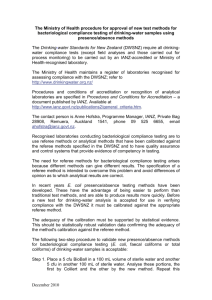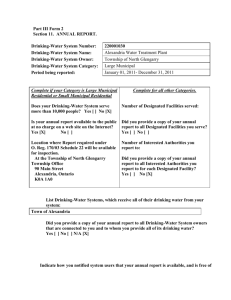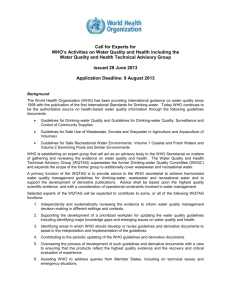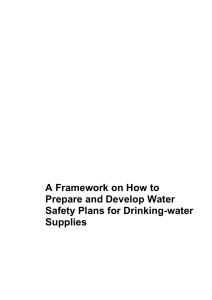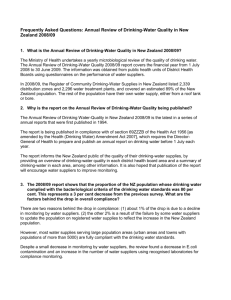Small Drinking-water Supplies: Preparing a water safety plan
advertisement
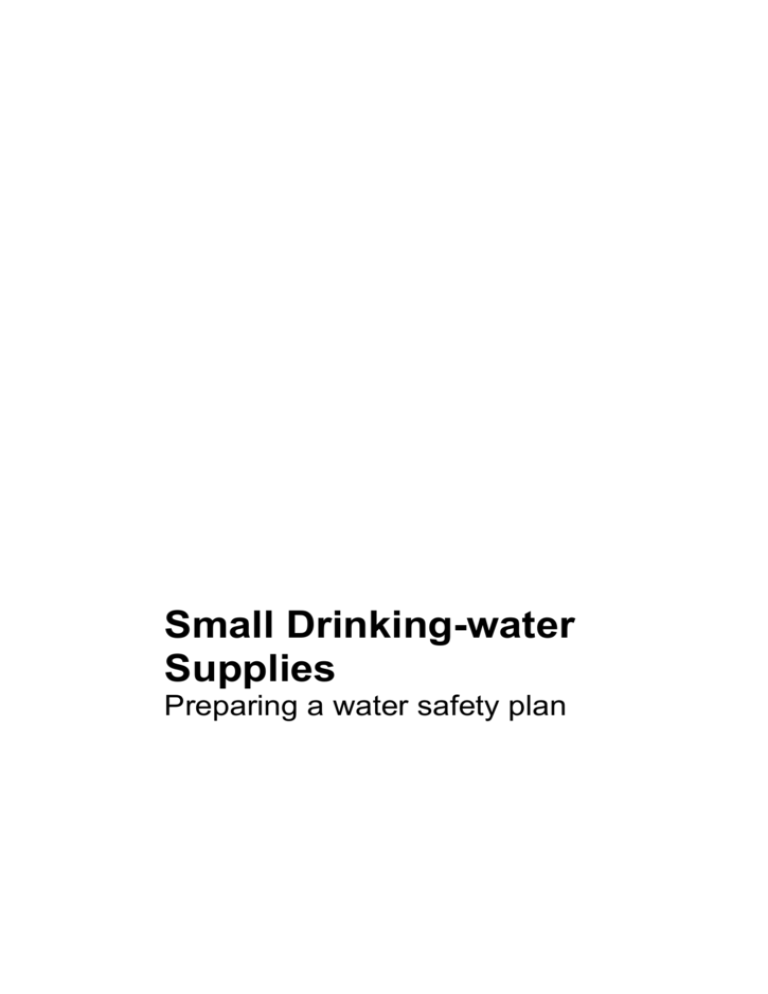
Small Drinking-water Supplies Preparing a water safety plan Citation: Ministry of Health. 2014. Small Drinking-water Supplies: Preparing a water safety plan. Wellington: Ministry of Health. Published in January 2014 by the Ministry of Health PO Box 5013, Wellington, New Zealand ISBN 978-0-478-42776-9 (print) ISBN 978-0-478-42777-6 (online) HP 4136 Previously published in 2005 as Small Drinking-water Supplies: Preparing a public health risk management plan. This publication’s title and any reference within the text to ‘public health risk management plan’ were changed in January 2014 to reflect the December 2013 legislation change of the term ‘public health risk management plan’ to ‘water safety plan’. No other changes have been made to this document. This document is available at: www.health.govt.nz Small Drinking-water Supplies Preparing a water safety plan Preparing, implementing and updating a water safety plan (formerly known as a Public Health Risk Management Plan, PHRMP) are requirements of ongoing compliance with the Drinking-water Standards for New Zealand 2005 (DWSNZ:2005) for participating small drinking-water supplies. Why prepare a water safety plan? Drinking-water, whether it comes from a river, stream, lake, rain, spring or groundwater, is at risk of being unsafe. What makes water safe is the care and consideration people have for activities and actions in the catchment, and in treatment, storage and distribution of the water. Water suppliers have a public health responsibility to ensure the provision of safe drinking-water to their communities. A well thought out water safety plan designed specifically for the supply will provide consumer confidence of consistently safe drinking-water. A water safety plan provides direction for improvements and expenditure, is a safeguard against changing operations staff and management, and is a learning resource for new staff. What is covered by the water safety plan? A water safety plan is a systematic assessment of every aspect of providing safe drinking-water which will identify and manage the events that could cause water quality to deteriorate and become unsafe to drink. The water safety plan covers three aspects of the supply: catchment and intake; treatment; and storage and distribution. The water safety plan helps identify whether any of the following four barriers to contamination are missing. Preventing contaminants entering the source water. Removing particles from the water (where many of the germs hide). Killing germs. Preventing recontamination after treatment. The water safety plan covers the following questions. 1. What could happen to cause the water quality to deteriorate and become unsafe to drink? 2. Which of these factors need urgent attention? 3. How do you know when the water quality is deteriorating to a point where action is needed? 4. How do you respond if action is needed? 5. How do you stop this happening in the future? Small Drinking-water Supplies: Preparing a water safety plan 1 How to prepare a water safety plan The following template has been developed to help you prepare a water safety plan for your supply (see the accompanying video/DVD and the Appendix in Chapter 19 of the Guidelines for Drinking-water Quality Management for New Zealand). STEP 1 is a simple drawing and description of the drinking-water supply. It highlights the major flows and influences. It is not a work of art or a detailed design plan. STEP 2 is based on the drawing of the supply, and there is one worksheet for each of the three aspects of the supply: catchment and intake; treatment; and storage and distribution. Each worksheet goes through questions 1 and 2 in the section above. The worksheets identify what needs urgent attention, the events of most concern because they happen a lot and/or could cause significant illness. STEP 3 focuses on those things that need urgent attention and develops a plan to manage these by working through questions 3 to 5 in the section above. The plan covers both the immediate responses and a longer-term Improvement Schedule. What to do with the plan The water safety plan will guide both day-to-day actions and long-term planning. It will identify regular monitoring and inspections that signal deteriorating water quality and prompt action. It will identify regular ongoing maintenance to reduce the chance of failure of any of the four barriers to contamination. It will list where to get help, who needs to know what about the status of the water safety plan and drinking-water quality, and how quickly they need to know. It will provide direction for improvements and expenditure. The Improvement Schedule should make clear which actions can be achieved with existing resources and which will require additional resources. The water safety plan should be reviewed annually, after any significant change to your water supply and in response to finding a weakness in your plan. Further information For further information please contact either your Health Protection Officer of the local District Health Board or your Environmental Health Officer at your Local District Council. You can also find more information on the specific components of a water supply on www.health.govt.nz/water 2 Small Drinking-water Supplies: Preparing a water safety plan Participating Small Drinking-water Supply Compliance Water Safety Plan Small Drinking-water Supplies: Preparing a water safety plan 3 Supply Name: Step 2: Worksheets Catchment and Intake List what could happen that may cause drinking-water to become unsafe (deterioration in water quality) Is this under control? If not, judge whether this needs urgent attention. Urgent attention is needed for something that happens a lot and/or could cause significant illness. 1. 2. 3. 4. 5. 6. 4 Small Drinking-water Supplies: Preparing a water safety plan Supply Name: Treatment List what could happen that may cause drinking-water to become unsafe (deterioration in water quality) Is this under control? If not, judge whether this needs urgent attention. Urgent attention is needed for something that happens a lot and/or could cause significant illness. 7. 8. 9. 10. 11. 12. Small Drinking-water Supplies: Preparing a water safety plan 5 Supply Name: Storage and Distribution List what could happen that may cause drinking-water to become unsafe (deterioration in water quality) Is this under control? If not, judge whether this needs urgent attention. Urgent attention is needed for something that happens a lot and/or could cause significant illness. 13. 14. 15. 16. 17. 18. 6 Small Drinking-water Supplies: Preparing a water safety plan Supply Name: Other List what could happen that may cause drinking-water to become unsafe (deterioration in water quality) Is this under control? If not, judge whether this needs urgent attention. Urgent attention is needed for something that happens a lot and/or could cause significant illness. 19. 20. 21. 22. Small Drinking-water Supplies: Preparing a water safety plan 7 Step 3: Plan to Manage the ‘Needs Urgent Attention’ Supply Name: Catchment and Intake Copy the ‘Needs Urgent Attention’ from the worksheets. Expect no more than 3–5 in each worksheet. 8 IMPROVEMENT SCHEDULE: How can you remove or reduce or remedy the cause and by when? Indicate clearly where additional resources are required. Small Drinking-water Supplies: Preparing a water safety plan Until remedied, how will you know when this is actually causing deterioration towards unsafe drinking-water? What contingency management plan is in place until the cause is removed or reduced or remedied? Who needs to know and how quickly? Who can help? Treatment Copy the ‘Needs Urgent Attention’ from the worksheets. Expect no more than 3–5 in each worksheet. Supply Name: IMPROVEMENT SCHEDULE: How can you remove or reduce or remedy the cause and by when? Indicate clearly where additional resources are required. Until remedied, how will you know when this is actually causing deterioration towards unsafe drinking-water? What contingency management plan is in place until the cause is removed or reduced or remedied? Who needs to know and how quickly? Who can help? Small Drinking-water Supplies: Preparing a water safety plan 9 Storage and Distribution Copy the ‘Needs Urgent Attention’ from the worksheets. Expect no more than 3–5 in each worksheet. 10 Supply Name: IMPROVEMENT SCHEDULE: How can you remove or reduce or remedy the cause and by when? Indicate clearly where additional resources are required. Small Drinking-water Supplies: Preparing a water safety plan Until remedied, how will you know when this is actually causing deterioration towards unsafe drinking-water? What contingency management plan is in place until the cause is removed or reduced or remedied? Who needs to know and how quickly? Who can help? Other Copy the ‘Needs Urgent Attention’ from the worksheets. Expect no more than 3–5 in each worksheet. Supply Name: IMPROVEMENT SCHEDULE: How can you remove or reduce or remedy the cause and by when? Indicate clearly where additional resources are required. Until remedied, how will you know when this is actually causing deterioration towards unsafe drinking-water? What contingency management plan is in place until the cause is removed or reduced or remedied? Who needs to know and how quickly? Who can help? Small Drinking-water Supplies: Preparing a water safety plan 11 Notes 12 Small Drinking-water Supplies: Preparing a water safety plan

